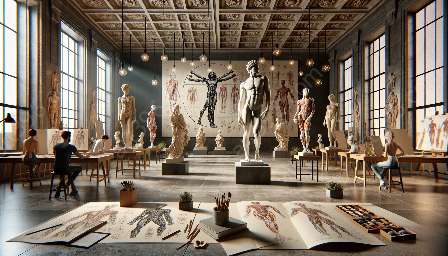The Renaissance period was an era of great cultural and scientific advancement. One area in which this progress was particularly evident was in the study of human anatomy. Renaissance anatomy played a crucial role in shaping the way the human body was understood and depicted in art, and its influence can still be seen in modern medical illustrations.
Renaissance Anatomy and Artistic Anatomy
The Renaissance was a time of renewed interest in the study of the human body, spurred by advancements in scientific understanding and a growing fascination with the human form. This period saw a surge in anatomical research and the development of detailed anatomical drawings and illustrations. Artists and anatomists worked closely together to create accurate depictions of the human body, leading to a deeper understanding of anatomy and its integration into art.
Renaissance artists, such as Leonardo da Vinci and Michelangelo, utilized their knowledge of anatomy to create lifelike and dynamic representations of the human body in their artwork. Their mastery of anatomical accuracy and understanding of musculature and skeletal structure brought a new level of realism to their creations, setting a standard for artistic anatomy that continues to influence artists and medical illustrators today.
Impact on Renaissance Art
The advancements in anatomical knowledge during the Renaissance had a profound impact on the art of the period. Artists sought to capture the human form with greater precision and realism, resulting in a shift towards naturalistic depictions of anatomy. This influence extended beyond the visual arts, shaping the portrayal of the human body in sculpture, literature, and other creative expressions. The Renaissance period marked a turning point in how the human body was understood and represented, laying the foundation for modern anatomical studies and medical illustrations.
Modern Medical Illustrations
Fast forward to the present day, and the legacy of Renaissance anatomy can be seen in the field of medical illustration. The accurate and detailed representations of the human body developed during the Renaissance continue to serve as a cornerstone of modern medical illustration. Medical illustrators combine artistic skill with scientific knowledge to create visually compelling and informative depictions of anatomy for educational and instructional purposes.
With advancements in technology, modern medical illustrations have evolved to include digital rendering, 3D modeling, and interactive visuals, offering new means of exploring and understanding the complexities of the human body. The influence of Renaissance anatomy is evident in the emphasis on precision and anatomical accuracy seen in contemporary medical illustrations.
Connecting Artistic Anatomy and Renaissance Art
Artistic anatomy, rooted in the understanding of the human body's structure and form, continues to be intertwined with Renaissance art and modern medical illustrations. The study of artistic anatomy provides a foundation for artists and medical illustrators alike, allowing them to create representations of the human body that are both anatomically accurate and visually compelling.
Through the exploration of Renaissance anatomy and its impact on artistic anatomy and Renaissance art, we gain an appreciation for the intricate details and advancements in medical depictions. The fusion of art and science continues to shape our understanding of the human body, inspiring creativity and innovation in the realms of art, medicine, and education.

